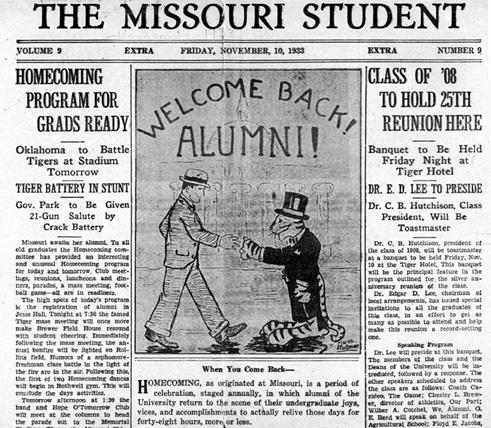
“Mizzou invented Homecoming,” are the three words constantly iterated to students — prospective and current alike. The event boasts an average of 70,000 participants every year. However, MU is not alone in claiming the creation of homecoming, competing with University of Illinois Urbana-Champaign and Baylor University for the creative credit. In the early 1900s, all three invited alumni to return “home” to cheer on their respective football team against a rival team. Parades, pep rallies and a home football game all remain hallmark traditions in homecoming celebrations across the U.S., but who really held the first ever homecoming?
In 1911, Missouri athletic director and head football coach Chester L. Brewer urged alumni to come “home” and attend their football game against rival University of Kansas. The game had historically been played in Kansas City, but new regulations required all intercollegiate football games to occur on campuses. Due to this change, the game was played in Columbia on Rollins Field, Missouri’s football field, later changed to Stankowski Field. Brewer’s call to alumni to “come home” drew a crowd of over 9,000 attendees.
“As I remember, Missouri was the first school to sponsor the idea of an annual reunion on the day of some important football game,” Brewer said in the early 1930s. The game ended in a tie with a 3-3 score.
University of Illinois Urbana-Champaign said they beat MU to the punch. In 1910, just one year prior to MU’s first Homecoming, two Illini seniors planned a campus-wide event to uplift school spirit in order to defeat their rival, the University of Chicago. Their football team had lost all games against Chicago for the past seven years and believed a full crowd of supporters could change this precedent. The event was a major success with the Illini proving victorious, as Illinois ended their seven-year loss streak against Chicago with a score 3-0. A record crowd of 12,000 attended, and the crowd was stacked with the school’s colors, orange and blue, thus starting the annual tradition of homecoming at Illinois.
Baylor University in Waco, Texas also claims to have first urged alumni to return “home”, but in 1909, two years prior to MU and one year prior to Illinois. Baylor’s primary reason, according to their website, was to “renew former associations and friendships and catch the Baylor spirit again.” A postcard was sent to alumni announcing Baylor would hold the university’s first ever “Good Will Week.” Baylor students and alumni filled Waco to watch a parade, formal dances, speeches and a home football game against opponent Texas Christian University. Baylor went on to win their first “Good Will Week” football game but would not hold another until six years later in 1915, and it would not become an annual tradition known as “homecoming” until 1934.
Homecoming at MU has grown to be the university’s biggest tradition since its inception in 1911. The week-long celebration has grown in the 111 years since then, most notably in Greek life. Members of the Panhellenic Association and Interfraternity Council display elaborate decorations across their historic houses and devote hours of their time pomping, rolling tissue paper into tiny balls that decorate the outside of the parade float, to prepare for the parade. The Friday night before the Homecoming parade and football game serves as an opportunity for people to head down and check out each houses’ decorations. Homecoming activities at MU also include a campus-wide blood drive, student talent shows and community service projects. Additionally, the Legion of Black Collegians hosts a week of homecoming festivities with events like the Black Renaissance Homecoming Ball, and a step-show performance from the National Pan-Hellenic Council.
The National Collegiate Athletic Association sanctions MU as the official creator of Homecoming, as does Jeopardy! and Trivial Pursuit. So who really invented homecoming? While it may be true that previous rival home football games drew alumni back to cheer on their respective teams prior to MU, coach Brewer’s call for alumni to “come home,” as well as establishing lasting homecoming traditions, accredits them with the title in MU’s eyes.
MU said in a press release, “Mizzou has consistently been recognized as having one of the largest, longest and best celebrations in the nation.”
Edited by Christian Dutcher | [email protected] by Zoe Homan | [email protected] edited by Emily Rutledge | [email protected]